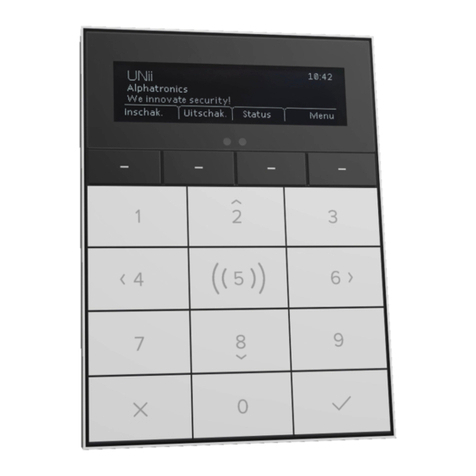
Installer manual AlphaVision ML Rev. 3.60 01-01-2015 4
Alarm relay output 1 and 2............................................................................................................. 62
Open collector output 3 and 4........................................................................................................ 63
Outputs 5-8 (V3.00 and above) ...................................................................................................... 63
KNX outputs (V3.50 and above)...................................................................................................... 63
Activate trigger output via a PIN-code, keyfob or (mobile) phone ............................................... 64
Quick arming................................................................................................................................... 68
Bypass ............................................................................................................................................. 68
Auto-reset (1-3 times) .................................................................................................................... 68
Panic alarm ..................................................................................................................................... 68
Duress code .................................................................................................................................... 68
Partial arming.................................................................................................................................. 68
Complete arming ............................................................................................................................ 69
Aux button ...................................................................................................................................... 69
Backlight and section LED screensaver option ............................................................................... 69
Arming- and disarming in historical log.......................................................................................... 69
Configuration .................................................................................................................................. 69
Jamming detection ......................................................................................................................... 70
House Identity................................................................................................................................. 70
Usercodes (V2.00 and higher) ........................................................................................................ 70
EN50131 mode (V2.00 and higher) ................................................................................................ 70
LS on walktest (V2.00 and higher) .................................................................................................. 71
Supervision Loud Alarm (V2.00 and higher) ................................................................................... 71
Doorbell via LS (V3.00 and higher) ................................................................................................. 71
EOL Resistor (V3.20 and higher) ..................................................................................................... 71
Total/Partial arming (V3.50 and higher)......................................................................................... 72
Keyswitch option (V3.60 and higher) ............................................................................................. 72
Battery monitoring (V3.60 and higher) .......................................................................................... 72
TIMERS MENU ....................................................................................................................................... 73
Alarm cancel ................................................................................................................................... 73
Inactivity ......................................................................................................................................... 73
Supervision alarm ........................................................................................................................... 74
Entry- and Exit delay times ............................................................................................................. 74
Siren (LS) time................................................................................................................................. 74
LS/AL1 delay.................................................................................................................................... 74
Outputs 1 to 8 activation time........................................................................................................ 74
230V power failure reporting delay (V3.50 and higher)................................................................ 76
DIALER ................................................................................................................................................... 76
PSTN/GSM REPORTING ......................................................................................................................... 78
Central station reporting 1 / 2 ........................................................................................................ 79
Central station telephone number ................................................................................................. 79
Account number ............................................................................................................................. 79
Protocol........................................................................................................................................... 79
Dial attempts .................................................................................................................................. 79
Private telephone settings.............................................................................................................. 80
Private telephone reporting ........................................................................................................... 80
Private telephone number.............................................................................................................. 80
Protocol........................................................................................................................................... 81
Dial attempts .................................................................................................................................. 81
Stop dial sequence for private reporting (v2.00 and higher) ......................................................... 81
Alarm messages .............................................................................................................................. 81
Central station messages................................................................................................................ 81




























